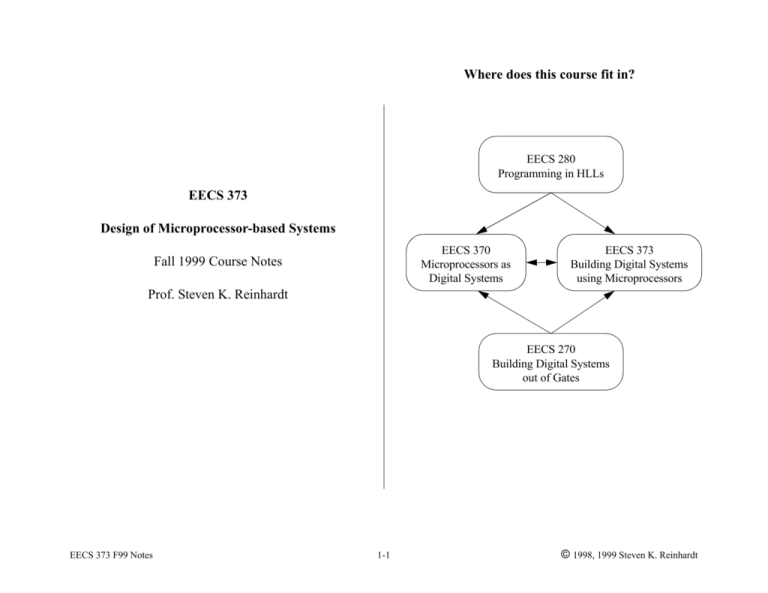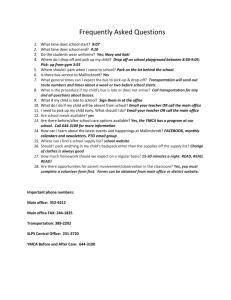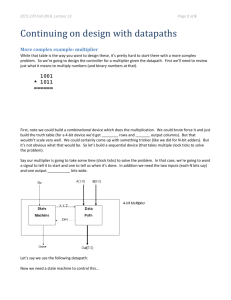EECS 373 Design of Microprocessor
advertisement

Where does this course fit in? EECS 280 Programming in HLLs EECS 373 Design of Microprocessor-based Systems EECS 370 Microprocessors as Digital Systems Fall 1999 Course Notes EECS 373 Building Digital Systems using Microprocessors Prof. Steven K. Reinhardt EECS 270 Building Digital Systems out of Gates EECS 373 F99 Notes 1-1 © 1998, 1999 Steven K. Reinhardt Overview Embedded vs. general-purpose systems What is this course about? • A microprocessor-based system that is dedicated to a specific task or tasks as part of a larger product is referred to as an embedded system. Although embedded systems get much less publicity, they vastly outnumber general-purpose systems in the market. how to design and build systems using microprocessors What are some examples of microprocessor-based systems? Why are more and more systems using microprocessors? • microprocessors are very cheap (< $1 at the low end) • an off-the-shelf microprocessor + software can replace a lot of application-specific logic • software enables flexible, sophisticated features that would be difficult or impossible otherwise • software is typically easier to debug & fix than hardware • more and more information is being stored and transmitted in digital form Source: Microprocessor Report This chart shows the number of 32-bit microprocessors shipped in 1997. On the left are processors shipped in embedded systems; on the right are processors shipped in general-purpose systems. Note that this chart does not include hundreds of millions of 8-bit and 16-bit embedded processors. EECS 373 F99 Notes 1-2 © 1998, 1999 Steven K. Reinhardt Generic microprocessor-based system Microprocessor-based System Features Unlike the digital systems you built in EECS 270, the physical interconnection of components in a microprocessor-based system doesn’t indicate its function. The system’s function is primarily determined by the software (instructions) executed by the processor. CPU Instead, all the primary system components are connected to a common bus. A bus is simply a group of signals (wires) that communicates among several devices. Two devices communicate when one device (typically the processor) sends data to or requests data from another device over the bus. Memory A typical microprocessor system bus is composed of three smaller busses: 1. address bus: indicates the device and location within the device that is being accessed 2. data bus: carries the data value that is being communicated 3. control bus: control signals that indicate what’s going on on the address and data busses Bus I/O Device The central processing unit (CPU) is the core of the processor where instructions get executed. Instructions are encoded in machine language, which maps every instruction to a binary value. We will primarily use assembly language in this class, which is a human-readable encoding of the same set of instructions. I/O Device high-level language:a = b + c assembly language: add r1, r2, r3 machine language: 01111100001000100001101000010100 EECS 373 F99 Notes 1-3 © 1998, 1999 Steven K. Reinhardt Memory Course topics (not in order) • Stores instructions (programs) & data • PowerPC architecture & assembly language programming • Organized as an array of locations (addresses), each storing one byte (8 bits). Reading (retrieving data from) a particular location always returns the last value stored (sent to) that location. • Bus designs, protocols, and interfacing • Standard busses (PCI, USB, etc) & bus bridging • Common I/O devices: • Timers • Analog-to-digital, digital-to-analog conversion • Serial I/O • Video • Interrupts: I/O devices demand attention • DMA: I/O devices talk directly to memory • Memory technologies: SRAM, DRAM (page mode, EDO, synchronous, Rambus), Flash, etc. I/O devices • Let system interact with the world • Device interface (a.k.a. controller or adapter) is digital logic that connects actual device to bus • examples? • I/O device registers look just like memory to the CPU: a bunch of locations that can be accessed over the bus. However, I/O device registers are connected to other things (external wires, device control logic, etc.) • Result: 1. reads usually don’t return last value written (e.g., may be value of last key pressed on keyboard instead) 2. writes usually have side effects (e.g., display character on screen) EECS 373 F99 Notes 1-4 © 1998, 1999 Steven K. Reinhardt







